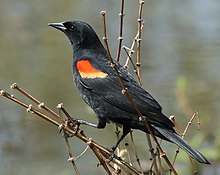 Though very common in North
America, this is the first recorded sighting of the species in
Europe. Since it was first spotted last Saturday, April 28, over between
50 and 60 birdwatchers have arrived on the island each day, hoping
to catch a glimpse.
Though very common in North
America, this is the first recorded sighting of the species in
Europe. Since it was first spotted last Saturday, April 28, over between
50 and 60 birdwatchers have arrived on the island each day, hoping
to catch a glimpse.NRBO’s Simon Davies explained that Red-winged blackbirds typically nest marsh areas.
This specimen has been feeding in the middle of the Iris beds on North Ronaldsay, but no one is quite sure how it got there.
With the volume of birdwatchers increasing, NRBO made the decision yesterday to “flush” the bird out of its new residence and into a more suitable area. They hope that this will prevent any damage being done to the Iris beds, which already provide an important breeding ground for the island’s waterfowl.
“When a bird is flushed, it involves a lone member of the observatory staff going through the known feeding area to push the bird out towards another favourable area for the bird,” NRBO explained in a statement on Twitter.
“As you’ll appreciate, the bird is very rare and the volume of twitchers on the island is high. Without the use of this policing technique, groups of twitchers would simply arrive on the sit, fan out over the area and trample the irises that breeding birds find so important.”
NRBO staff also confirmed that they will be continuing to monitor the area, round-the-clock, in order to protect the both the bird and its habitat.
sOURCE
No comments:
Post a Comment